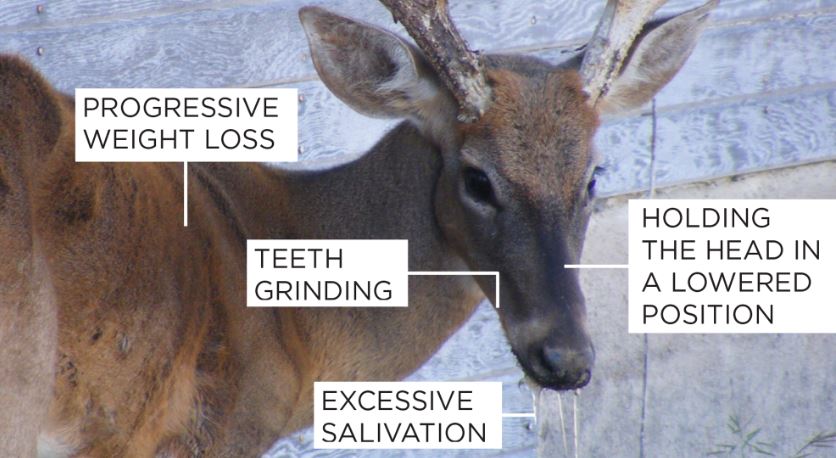CWD Found in Limestone County
Texas Parks and Wildlife Department (TPWD) and Texas Animal Health Commission (TAHC) discovered Chronic Wasting Disease (CWD) in Limestone County. A white-tailed deer within a breeding facility tested positive for CWD. The is marks the first positive detection of CWD in Limestone County. With deer season just around the corner, will this affect hunters?
The deer was found as part of a required CWD surveillance program. Samples from four deer were detected with CWD prions by the Texas A&M Veterinary Medical Diagnostic Laboratory in College Station on September 5. The National Veterinary Services Laboratory in Ames, Iowa confirmed CWD in two of these samples on Sept. 13. In addition, the lab should complete testing of the other two samples soon.

Animal health and wildlife officials have taken action to secure the deer breeding facility. State officials must now identify and notify other breeding facilities that received deer or shipped deer to this facility in the last five years. CWD seems to be on the move, as earlier this month CWD was found in Gillespie County. The recent news makes you wonder where CWD will be found in Texas next?
Looking at CWD in Limestone County
“TPWD and TAHC are taking this situation very seriously,” said John Silovsky, Wildlife Division Director for TPWD. “Fortunately, these positive cases were detected early, and we have a good sample distribution across the facility. At this time, CWD appears to be contained to one pen within the facility.
Animal health and wildlife officials will continue to investigate to determine the extent of the disease within the facility and mitigate risks to Texas’ CWD susceptible species. Quick detection of CWD in Limestone County can help mitigate the disease’s spread.”
CWD Zone in Limestone County
TPWD officials are developing surveillance zone boundaries that may include portions of Limestone, Hill, Freestone and Navarro counties. CWD zones are an effective strategy for managing and containing the disease. Hunters in surveillance and containment zones must take harvested CWD susceptible species to a check station or otherwise meet submission requirements.
TPWD will provide additional information to landowners and hunters within the surveillance zone regarding CWD sampling locations. Furthermore, TPWD will provide options to have white-tailed deer or other CWD susceptible species tested. There is no cost to the hunter for this testing. A public meeting will be held concerning CWD in Limestone County prior to implementation to provide the details of the zones and CWD management.
“Surveillance is an essential part of managing CWD,” said Dr. Andy Schwartz, TAHC Executive Director and State Veterinarian. “While the disease’s incubation period poses challenges, quick detection can help mitigate the disease’s spread and protect cervid populations in Texas.”
Testing Required with CWD in Limestone County
Testing for CWD allows wildlife biologists and animal health officials to get a clearer picture of the prevalence and distribution of the CWD disease across Texas. Additionally, proactive monitoring improves the state’s response time to a CWD detection and can greatly reduce the risk of the disease spreading further to neighboring captive and free-ranging populations.
TPWD and TAHC encourage hunters outside of established surveillance and containment zones to voluntarily submit their harvest for testing at a check station, for free, before heading home from the field. A map of TPWD check stations can be found on the TPWD website. CWD testing required for exotic deer in Texas according to TAHC, regardless of location.
CWD in Texas and Beyond
First recognized in 1967 in captive mule deer in Colorado, CWD has since been documented in captive and/or free-ranging deer in 30 states and three Canadian provinces. To date, 392 captive or free-ranging cervids — including white-tailed deer, mule deer, red deer and elk — in 16 Texas counties have tested positive for CWD.
CWD is a fatal neurological disease found in certain cervids, including deer, elk, moose and other members of the deer family. The disease is highly transmissible and can remain infectious on the landscape for several years. If left unmanaged, CWD can have long-term impacts on the native deer herd and local economies.
Clinical signs may include progressive weight loss, stumbling or tremors with a lack of coordination, excessive thirst, salivation or urination, loss of appetite, teeth grinding, abnormal head posture and/or drooping ears. These signs may not become evident until long after animals have become infected. Therefore, testing remains the best available tool for detecting CWD at an early stage and containing it with appropriate management strategies.
To date, there is no evidence that CWD poses a risk to humans or non-cervids. However, as a precaution, the U.S. Centers for Disease Control and the World Health Organization recommend not to consume meat from infected animals. However, because there is CWD in Limestone County deer, local hunters need to be aware of testing requirements.